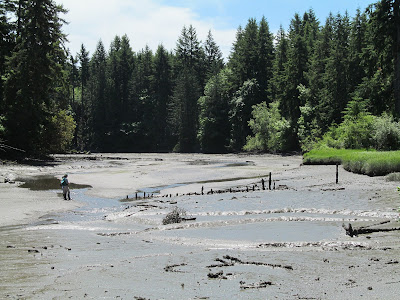Thanks to stevenl on olyblog for
posting
this down-Deschutes shot. He thinks the postcard dates to the
mid-1970s, a time when the Olympia Brewing Company still ran strong, and
was so proud of it's beige industrial sprawl they issued this image,
rather than the charming old brick building.
Olympia's
motto, of course, was "It's the Water," and we do have great water, our
artesian wells are famous, delicious, and clean. But surface water is an
other story, a sad one, as this shot illustrates.
In
the foreground, the Deshutes River, in summertime flaccid flow. Could
just be a dead-calm day, but I feel like there's an oil sheen. Maybe
not.
As far as the river is visible, the brewery takes
up the right bank. Since I'm too lazy to track it down, I don't know
what they may have flushed into the river as part of normal operations,
but up until about the date of this postcard, when Dick Nixon signed the
Clean Water Act (what a liberal!), people and corporations did dump all
kinds of things in the water. All this view shows is a treeless bank
and acres of impervious surface, which when the rain kicks in will dump
huge amounts of runoff compared to what the natural watershed would
have, not to mention the sediment, railway grime, and other trappings of
civilization.
Which the river then delivers
to,...Wait, I cannot see. It disappears on the other side of the Capital
Boulevard bridge, past more brewery buildings, over the spillway...I
mean Falls, and finally past the old brew house, Olympia's most famous
ruin. There's a park on the other bank now, and the old brewery is
abandoned. You can kid yourself into thinking it's returning to nature
as long as you deafen yourself to the I-5 din.
But
really, the Deschutes is about to empty into Capitol Lake. Or, as
stevenl calls it, the Fetid Lake Of Doom, or FLOD. Flotsam and sediment
from the watershed settle out here. In fact, the muck contains the
remains of Little Hollywood (Olympia's Depression-era Hoovertown), and
before that a literally marginalized Chinese community, I think. The
artificial lake relies on a dam that transformed the original estuary
into a pond (yep, the reflection of capitol and trees sure is pretty)
with a sluice being the only way out. So the estuary gets buried and
eutrophies (yep, the low tides and summer algae blooms sure are ugly).
The
postcard more or less hides The Isthmus, site of many a battle in this
millenium. Positions on Isthmus development cause the city council to
change, parts of it were Occupied, it is home to Olympia's second most
famous ruin: the Mistake on the Lake. Walk around the lake, and you'll
see signs explaining various positions in the Debate of the Lake: dredge
it, restore the estuary, do nothing...There is no sign saying "Isthmus
be Hell."
Meanwhile, the lake keeps filling with muck,
and the water keeps flowing into Budd Inlet. The head of Budd is
divided into West Bay, which is where the Deschutes comes in, and East
Bay, which is where a culvert let's loose what's left of Indian and
Moxlie Creeks. Most of the city between East and West is built on
dredging spoils and fill.
West Bay is undergoing a
transformation these days, as the buildings and piers of yesteryear's
manufacturing concerns disappear. Some of it is undergoing restoration,
as far as a railway embankment can be restored to a natural state. But
people are not about to abandon the waterfront entirely, ceding it to
nature. So pockets of "beach nourishment" gravel and chained-down "large
woody debris" have to coexist with armored shorelines in a state that I
will now call Percivaltory, after Percival's Landing on the waterfront.
In the postcard, it looks like there may be log booms
in the bay. No more, although the POO (Port Of Olympia) is hopping,
putting trucked-in logs on trans-Pacific ships. The watershed's wood
(state timber excepted) flows all the way to China.






